 W
WAcropoma japonicum, the glowbelly, is a fish species in the family Acropomatidae found in the Indo-West Pacific. It is a benthopelagic predatory fish with a bioluminescent organ on its ventral surface. The glowbelly is an important food fish in some areas.
 W
WThe Amazon molly is a freshwater fish native to warm, fresh waters between Tuxpan River in northeastern Mexico and the Rio Grande and the Nueces River in the extreme southern parts of the U.S. state of Texas. It reproduces through gynogenesis, and essentially all individuals are females. The common name acknowledges this trait as a reference to the Amazon warriors, a female-run society in Greek mythology.
 W
WAmeiurus platycephalus, the flat bullhead, is a species of North American freshwater catfish native to the waters of the southeastern United States from Virginia to Georgia. This species grows to a maximum length of 29 cm (11 in) TL though it is more commonly about 23 cm (9 in) long.
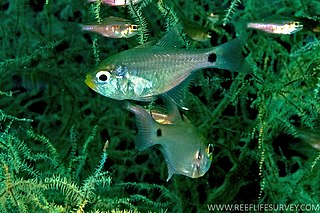 W
WArchamia bleekeri, also known as Gon's cardinalfish, is a species of fish in the family Apogonidae, the cardinalfishes. It is native to the coastal waters of the Indian Ocean and the western Pacific Ocean from Africa to Indonesia and from Taiwan to Queensland, Australia. This species occurs in mangrove forests and reefs, and is an inhabitant of shipwrecks, preferring silty areas with muddy or sandy substrates. This species grows to a total length of 10 cm (3.9 in). This species is the only member of its genus. The other species were moved to the new genus Taeniamia in 2013.
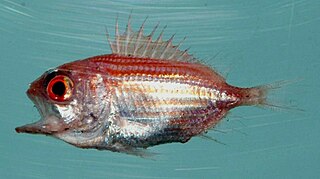 W
WThe bigeye soldierfish is a soldierfish species belonging to the family Holocentridae.
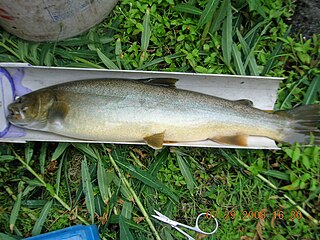 W
WThe bull trout is a char of the family Salmonidae native to northwestern North America. Historically, S. confluentus has been known as the "Dolly Varden", but was reclassified as a separate species in 1980. Bull trout are listed as a threatened species under the U.S. Endangered Species Act (1998) and as vulnerable on the IUCN Red List of Threatened Species.
 W
WThe California halibut or California flounder is a large-tooth flounder native to the waters of the Pacific Coast of North America from the Quillayute River in Washington to Magdalena Bay in Baja California. It feeds near shore and is free swimming. It typically weighs 6 to 30 pounds. It is much smaller than the larger and more northern-ranging Pacific halibut that can reach 300 pounds (140 kg).
 W
WThe California moray is a moray eel of the family Muraenidae, found in the eastern Pacific from just north of Santa Barbara to Santa Maria Bay in Baja California. They are the only species of moray eel found off California, and one of the few examples of a subtropical moray. They typically occupy boulder or cobble habitats up to 40 m in depth. They can attain lengths of about 5 ft (1.52 m) and are believed to live for upwards of 22–26 years. Like other morays, they have no pelvic or pectoral fins or gill covers.
 W
WChaenogobius annularis, the fork-tongued goby, is a species of goby from the subfamily Gobionellinae which is found in the brackish waters of temperate eastern Asia. It is the type species of the genus Chaenogobius.
 W
WThe chameleon goby is a species of ray-finned fish native to marine and brackish waters along the coasts of eastern Asia. It has also spread to other parts of the world where it is found in waters with varying degrees of salinity.
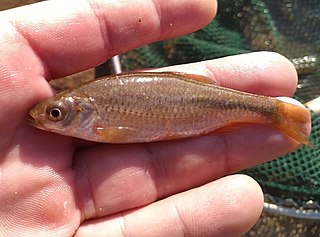 W
WThe Dnieper chub or the Black Sea chub is a species of cyprinid fish from Eastern Europe. It is found in Bulgaria, Georgia, Greece, Moldova, Romania, Russia, Turkey, and Ukraine. It lives up to eight years.
 W
WThe eastern mosquitofish is a species of freshwater fish, closely related to the western mosquitofish, Gambusia affinis. It is a member of the family Poeciliidae of order Cyprinodontiformes. The eastern mosquitofish is native to the eastern and southern United States from Florida to Pennsylvania and inland to Alabama and Tennessee, while the western mosquitofish has a larger distribution throughout the United States.
 W
WThe eastern nannygai, also known as the redfish, bight redfish, red snapper, golden snapper or koarea, is an alfonsino of the genus Centroberyx. It is found around Australia and New Zealand at depths between 10 and 450 metres on the continental shelf. It can reach lengths of up to 51.0 centimetres (20.1 in) SL. It forms schools near the sea floor over rocky reefs and mud at dawn and dusk, splitting up at night to feed on mollusks, crustaceans, and small fish. Its young live in estuaries and shallow coastal waters.
 W
WThe eastern talma or truncate coralfish, is a species of butterflyfish in the genus Chelmonops endemic to Australia. It is an omnivore, feeding on small crustaceans, worms and filamentous algae.
 W
WEchidna xanthospilos is a moray eel found in the western central Pacific Ocean, around Indonesia and Papua New Guinea. It was first named by Pieter Bleeker in 1859. Its common names include yellow-spotted moray and skeletor moray.
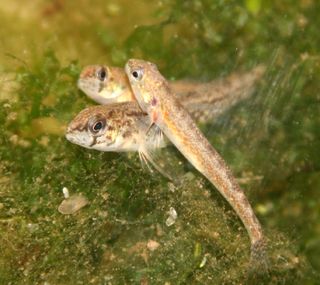 W
WEtheostoma exile, the Iowa darter, is a species of freshwater ray-finned fish, a darter from the subfamily Etheostomatinae, part of the family Percidae, which also contains the perches, ruffes and pikeperches. It is, along with about 17 other species of darters, is native to the lakes and streams of Iowa.
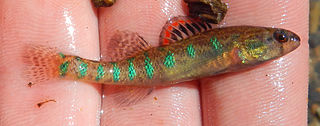 W
WEtheostoma gracile, the slough darter, is a small species of ray-finned fish, a darter from the subfamily Etheostomatinae, part of the family Percidae which includes the perches, ruffs and pike-perches. It inhabits slow to moderately flowing waters and with substrates that are predominantly mud, silt, or sand. Major food sources include chironomids, copepods, and cladocerans, as well as mayflies in the spring. Adults reach 35 to 50 mm total length. It is one of the 324 species of fish found in Tennessee.
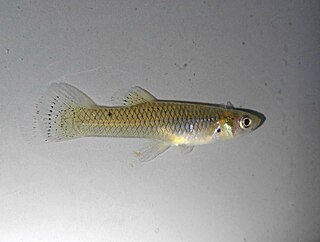 W
WGambusia speciosa, the Tex-Mex gambusia, is a species of fish in the family Poeciliidae which is found in the United States and Mexico. In Mexico its range covers the states of Chihuahua, Coahuila, Nuevo León and Tamaulipas while in the United States it is found in New Mexico and Texas. In Texas it is restricted to the Devils River and its tributaries in Val Verde County. The habitat of the Tex-Mex gambusia includes springs, outflow channels, marshes and the margins of small to medium-sized streams. This species was described by Charles Frédéric Girard in 1859 with the type locality given as the Río San Diego, near Cadereita in Nuevo León.
 W
WThe giant moray is a species of moray eel and a species of marine fish in the family Muraenidae. In terms of body mass, it is the largest moray eel; however, the slender giant moray is the largest in terms of body length.
 W
WThe giant sea bass is a fish native to the North Pacific Ocean. Although commonly referred to as a giant sea bass, black sea bass or giant black sea bass, it is actually a wreckfish in the family Polyprionidae rather than in the sea bass family Serranidae
 W
WThe guppy, also known as millionfish and rainbow fish, is one of the world's most widely distributed tropical fish and one of the most popular freshwater aquarium fish species. It is a member of the family Poeciliidae and, like almost all American members of the family, is live-bearing. Guppies originate from northeast South America, but have been introduced to many environments and are now found all over the world. They are highly adaptable and thrive in many different environmental and ecological conditions. Male guppies, which are smaller than females, have ornamental caudal and dorsal fins. Wild guppies generally feed on a variety of food sources, including benthic algae and aquatic insect larvae. Guppies are used as a model organism in the fields of ecology, evolution, and behavioural studies.
 W
WHaemulon chrysargyreum, commonly called smallmouth grunt or yellowstripe grunt, is a species of marine fish in the family Haemulidae.
 W
WThe ribboned pipefish, ribboned pipehorse or ribboned seadragon, is a species of pipefish found along the coast of northern Australia and New Guinea in habitats ranging from shallow and weedy to deeper and sandy bottoms down to depths of 16.5 m (54 ft). This species grows to a total length of 30 cm (12 in). Their colors can range from greenish yellow to brownish red. This species is the only known member of its genus.
 W
WHeterandria formosa is a species of livebearing fish within the family Poeciliidae. This is the same family that includes familiar aquarium fishes such as guppies and mollies. Heterandria formosa is not as commonly kept in aquaria as these species. H. formosa is one of the smallest fish in the world, and is the smallest fish found in North America. Despite the common name "least killifish", it belongs to the family Poeciliidae and not to one of the killifish families.
 W
WThe Italian loach is a species of ray-finned fish in the family Cobitidae. It is found only in Italy. It is threatened by habitat loss.
 W
WKing-of-the-salmon, Trachipterus altivelis, is a species of ribbonfish in the family Trachipteridae. Its common name comes from the legends of the Makah people west of the Strait of Juan de Fuca, which hold that this fish leads the salmon annually to their spawning grounds. Catching or eating king-of-the-salmon was forbidden, as it was feared killing one would stop the salmon run. This myth is reflected by a former specific epithet used for this fish, rex-salmonorum, rex being Latin for "king". The king-of-the-salmon is found in the eastern Pacific Ocean from Alaska to Chile. It is usually found in the open ocean to a depth of 900 meters, though adults sometimes feed on the sea bottom.
 W
WThe large-scale whiting the only member of the genus Sillaginops, is a poorly understood species of coastal marine fish of the smelt- whiting family Sillaginidae. First described in 1859, the large-scale whiting is known to inhabit shallow waters along the coasts of a number of Indo-Pacific countries including Japan, Indonesia, Philippines and the Solomon Islands. Little is known of the species biology, even though it is of minor importance to fisheries throughout its range.
 W
WLeiopotherapon unicolor, the spangled grunter or spangled perch is a species of ray-finned fish, a grunter from the family Terapontidae. It is endemic to Australia.
 W
WThe Mexican darter, also known as the Chihuahua darter or Mexican darter, is a species of freshwater ray-finned fish, a darter from the subfamily Etheostomatinae, part of the family Percidae, which also contains the perches, ruffes and pikeperches. It is endemic to Mexico where it is the only species of darter to naturally occur in the Pacific drainage. This species can reach a length of 5.5 centimetres (2.2 in) TL.
 W
WMobula eregoodootenkee is a species of ray in the family Mobulidae. It is endemic to the Indian Ocean and central-west Pacific Ocean. It ranges from South Africa in the west to the Philippines in the east, north to Vietnam, and south to the northern coast of Australia.
 W
WThe Monterrey platyfish is a species of freshwater fish in family Poecilidae. A live-bearer, it was native to a very small section of the San Juan River system in the vicinity of the city of Monterrey, Mexico. The specific name refers to the American soldier and naturalist Darius N. Couch (1822-1897) who collected the type on a self financed expedition to Mexico.
 W
WThe Pacific angelshark is a species of angelshark, family Squatinidae, found in the eastern Pacific Ocean from Alaska to the Gulf of California, and from Ecuador to Chile, although those in the Gulf of California and southeastern Pacific may in fact be separate species. The Pacific angelshark inhabits shallow, coastal waters on sandy flats, usually near rocky reefs, kelp forests, or other underwater features. This species resembles other angel sharks in appearance, with a flattened body and greatly enlarged pectoral and pelvic fins. Characteristic features of this shark include a pair of cone-shaped barbels on its snout, angular pectoral fins, and a brown or gray dorsal coloration with many small dark markings. It attains a maximum length of 1.5 m (4.9 ft).
 W
WThe Pacific seahorse, also known as the giant seahorse, is a species of fish in the family Syngnathidae. This species is the only seahorse species found in the eastern Pacific Ocean.
 W
WThe Palespotted eel is an eel in the family Ophichthidae. It was described by Johann Jakob Kaup in 1859, originally under the genus Cryptopterus. It is a marine, tropical eel which is known from the western Atlantic Ocean, including North Carolina, USA, the northeastern Gulf of Mexico, and Brazil. It dwells at a depth range of 0 to 150 metres, most often at around 5 to 40 metres. Males can reach a maximum total length of 81 centimetres (32 in), but more commonly reach a TL of 60 centimetres (24 in).
 W
WPercina maculata, the blackside darter, is a species of freshwater ray-finned fish, a darter from the subfamily Etheostomatinae, part of the family Percidae, which also contains the perches, ruffes and pikeperches. It is a widespread inhabitant of streams and rivers in the Mississippi River watershed. Like other darters it prefers rocky riffles and sandy runs, but is tolerant of pools and still water as well. It is one of the 324 fish species found in Tennessee.
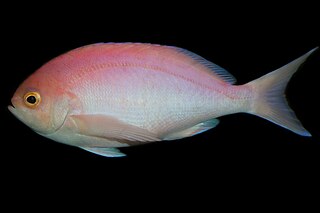 W
WThe pink maomao, also known as the longfin perch, is a species of marine ray-finned fish, a member of the subfamily Anthiinae which is part of the grouper and sea bass family Serranidae. It is found in the southern Pacific and the southeastern Indian Ocean.
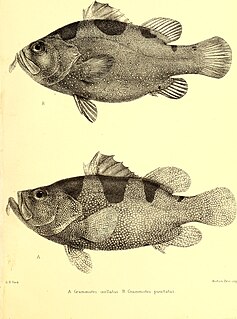 W
WPogonoperca ocellata, the Indian soapfish or snowflake soapfish, is a species of marine ray-finned fish, related to the groupers and classified within the subfamily Epinephelinae of the family Serranidae. It is found in the Indian Ocean.
 W
WPolysteganus praeorbitalis, the Scotsman or Scotsman seabream, is a species of marine fish in the seabream family (Sparidae) of order Perciformes. It is native to Southern Africa.
 W
WPuntioplites waandersi is a species of ray-finned fish in the genus Puntioplites from south east Asia and the islands of Sumatra and Borneo.
 W
WThe redear sunfish, also known as the shellcracker, Georgia bream, cherry gill, chinquapin, improved bream, rouge ear sunfish and sun perch) is a freshwater fish in the family Centrarchidae and is native to the southeastern United States. Since it is a popular sport fish, it has been introduced to bodies of water all over North America. It is known for its diet of mollusks and snails.
 W
WThe redfin darter is a species of freshwater ray-finned fish, a darter from the subfamily Etheostomatinae, part of the family Percidae, which also contains the perches, ruffes and pikeperches. It is native to the south-central United States, where it occurs in Missouri, Arkansas, Kansas, and eastern Oklahoma.
 W
WThe Rio Grande darter is a small species of ray-finned fish, a darter from the subfamily Etheostomatinae, part of the family Percidae which includes the perches, ruffs and pike-perches. It is endemic to the lower Rio Grande drainage of the United States and Mexico. It inhabits riffles over substrates of gravel or rubble. This species can reach a length of 6 cm (2.4 in), though most only reach about 3 cm (1.2 in). The Rio Grande darter was first formally described as Oligocephalus grahami in 1859 by the French zoologist Charles Frédéric Girard (1822-1895) with the type locality given as the Devils River in Texas. The specific name honors the American soldier and topographer James Duncan Graham (1795-1865), who led the expedition on which the type was collected by John H. Clark.
 W
WSargocentron ensifer, more commonly known as the yellow-striped squirrelfish, is a member of the family Holocentridae. It is native to the Pacific Ocean from southern Japan to New Caledonia, Hawaii and the Pitcairn Islands. It lives in deep reefs at depths between 0 and 64 metres, hiding in crevices by day and foraging for food by night. It feeds on small fishes and crustaceans and can reach sizes of up to 23.0 centimetres (9.1 in) SL, though a length of 15.0 centimetres (5.9 in) TL is more common.
 W
WSargocentron microstoma, the fine-lined squirrelfish, slender squirrelfish or smallmouth squirrelfish, is a member of the family Holocentridae. It has a wide range throughout the Indo-Pacific from the Chagos Archipelago, Seychelles, and the Maldives to the Hawaiian Islands, Line Islands, and the Tuamotus Archipelago, north to the Ryukyu Islands and Bonin Islands, south to Austral Islands and throughout Micronesia. It lives near reefs usually at depths between 1–35 m (3.3–114.8 ft), but can be found as deep as 183 m (600 ft). During the day it hides in crevices, especially near Acropora and Pocillopora. It is a nocturnal predator, feeding on crustaceans, worms, and fishes. It can reach sizes of up to 20 cm (7.9 in) TL and has a venomous preopercle.
 W
WThe satinfin shiner is a species of fish in the family Cyprinidae, the carps and minnows. It is native to the eastern United States, where its distribution extends from New York to South Carolina. It is a common fish and not considered threatened.
 W
WSebastes elongatus is a species of fish in the rockfish family found in the northeast pacific.
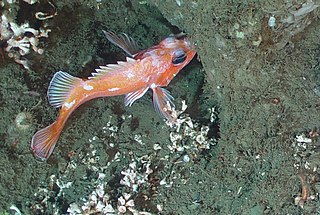 W
WSebastes helvomaculatus is a species of fish in the rockfish family found in the Eastern Pacific.
 W
WThe Seminole killifish is a fish of the genus Fundulus, endemic to the U.S. state of Florida.
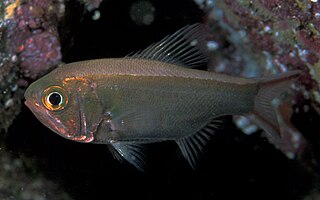 W
WThe slender roughy is a fish of the family Trachichthyidae. Until 2004 when two new species were described, the slender roughy was believed to be the only species in the genus Optivus. The slender roughy is found in the southwestern Pacific Ocean around New Zealand at depths between 10 and 100 m. Its length is up to 102 mm (4.0 in) standard length or 120 mm (4.7 in) overall total length.
 W
WThe spotted snake-eel, also known as the tiger snake eel or the spotted tiger snake eel, is an eel in the family Ophichthidae. It was described by Charles Frédéric Girard in 1859. It is a marine, tropical eel which is known from the eastern central and southeastern Pacific Ocean, including Chile, Costa Rica, Colombia, El Salvador, Ecuador, Mexico, Guatemala, Nicaragua, Panama, Honduras, and Peru. It dwells at a depth range of 0 to 60 metres, and inhabits benthic sediments of mud and sand. Males can reach a maximum total length of 74 centimetres (29 in), but more commonly reach a TL of 60 centimetres (24 in).
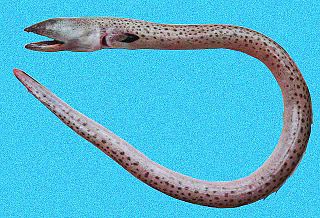 W
WThe stippled spoon-nose eel is an eel in the family Ophichthidae. It was described by Johann Jakob Kaup in 1859. It is a marine, tropical eel which is known from the western and eastern Atlantic Ocean, including the Gulf of Mexico, Cuba, northern South America, Senegal, and Angola. It dwells at a depth range of 40 to 100 metres, and inhabits shallow bays and lagoons, in which it forms burrows in mud and sand. Males can reach a maximum total length of 180 centimetres (71 in), but more commonly reach a TL of 100 centimetres (39 in).
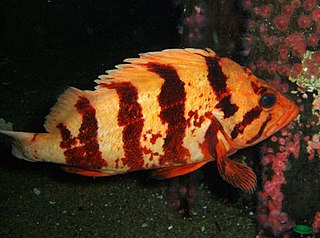 W
WThe tiger rockfish, also called tiger seaperch, banded rockfish and black-banded rockfish, is a fish found in rocky reefs and boulder fields. It is found in the northeast Pacific Ocean off Kodiak Island, and from Prince William Sound, Alaska, south to Point Buchon, central California. This species of fish is territorial, and somewhat aggressive in certain cases. The fish lurks between crevices in rocks, and coral reefs.
 W
WTyphlichthys subterraneus, the southern cavefish, is a species of cavefish in the family Amblyopsidae endemic to karst regions of the eastern United States.
 W
WThe Ukrainian stickleback also known as the Caspian ninespine stickleback, southern ninespine stickleback, and Aral ninespine stickleback, is a species of fish in the family Gasterosteidae. It is found in Afghanistan, Bulgaria, Iran, Kazakhstan, Moldova, Romania, Russia, Serbia, Montenegro, and Ukraine.
 W
WUropterygius xanthopterus is a moray eel found in coral reefs in the Pacific and Indian oceans. It is commonly known as the freckleface reef-eel, spottedface moray, or the white-speckled snake moray.
 W
WThe yellowbanded perch, also known as the yellowbanded wirrah and girdled rock cod, is a species of ray-finned fish in the family Serranidae, the groupers and sea basses. It is native to the southern Pacific Ocean, where it occurs along the coasts of eastern Australia and New Zealand.
 W
WAcanthopagrus australis, the yellowfin bream, also known as sea bream, surf bream, silver bream or eastern black bream, is a species of marine and freshwater fish of the porgy family, Sparidae. It is a deep-bodied fish, occasionally confused with Acanthopagrus butcheri, but is generally distinguished by its yellowish ventral and anal fins. It is a popular target for recreational fisherman due to its capacity to fight well above its weight coupled with its table quality.